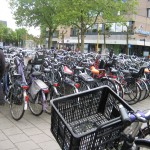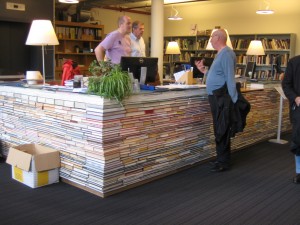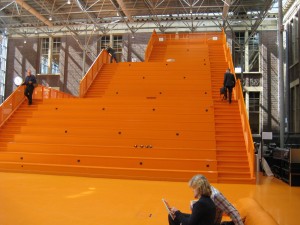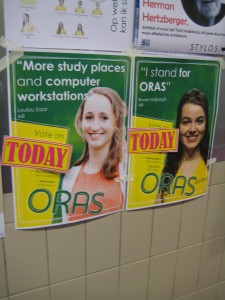I made a flying visit to Rotterdam in May as I was lucky to be able to join a study tour of Dutch libraries, organised loosely under the SCONUL umbrella by library and learning space consultant Les Watson. “Crazy spaces make great places” was the strapline for the trip, intended to showcase innovative architectural ideas and demonstrate how clever and experimental design has been applied to reinvent traditional spaces.
My luck was twofold really – it’s a privilege to have an opportunity to be involved in activities like this as they give a great opportunity to visit other libraries and network with colleagues. But the major element of fortune, or misfortune, around this trip related to my travel arrangements. Due to a runway defect at London City Airport, all incoming and outbound flights were grounded on the morning I was due to fly out.
While I was clicking my heels and climbing the walls at City Airport waiting for take off, I garnered some facts – such as 81% of City Airport passengers have a University degree and 98% of passengers carry a wireless device. Interesting nuggets in their own right – but not the sort of thing my LLT colleagues really expected me to bring back from this trip.
Six hours later than planned, I was navigating my way through the streets of Rotterdam to join the rest of the party. By this time, they’d enjoyed visits to the city’s impressive new Market Hall and and Bookmountain
I arrived in time for an unusual but very satisfying dining experience courtesy of the Foodcurators and some convivial chat with the rest of the group – a good mix of librarians from various H.E institutions as well as architects specialising in education projects.
The group had some real expertise in our midst with Rob Bruijnzeels and Joyce Sternheim of the Ministry of Imagination joining us. The buildings included in our programme drew on the many library and education related projects which they had been involved in design and consultation work.
First stop on Day 2 was the town of Delft, a short 20 minute train journey from Rotterdam , to visit the University of Technology. The Faculty of Architecture had been relocated into a former Chemistry faculty building in 2009 after its premises were destroyed by fire. Using their in-house expertise, allied with other local architects, the building had been comprehensively repurposed with a library at the heart of it and rebranded as BK City. The library itself was quite small, with just under 200 study spaces, but the emphasis was very much on students and staff being encouraged to share communal learning spaces throughout the building.
Here are some photos to give you a taste of the library and building in general
Why wait for a book distribution company to collect your withdrawn books when they can be used to build a library service desk?
NB – the box in the foreground is not a permanent feature.
Various quirky features could be noted around the building – a large teapot painted on the wall to signpost a snack area, and this curiously designed phone point just outside the library entrance
The centrepiece of the building was the impressive and eye catching lecture space and staircase. This couldn’t help but bring back memories of watching the Dutch national team in action with their orange clad supporters commandeering the stands!
As if to prove that many Higher Education issues are universal, Student Council elections were taking place and issues on the campaign posters resonated with most of our group.
Next stop was Gouda, another short train journey from Rotterdam Central. Although famous for its cheese, our destination was the Chocolate Factory.
The town’s library service had been reinvigorated after taking up residence in a former chocolate factory premises, which had more recently served as a municipal building. A round of local authority cuts five years ago had forced the council into a change of direction with 4 existing branch libraries closed and a decision taken to concentrate the library service into one central facility.
The building provides shared space for Gouda City Library, the Mid-Holland Regional Archive, Gouda Fine Printing Society and the Kruim Restaurant. The Ministry of Imagination had been commissioned as architects and designers for the entire project, working closely with all the parties involved. There was a strong commitment to putting the public at the heart of the space and no visible boundaries between the different functions.
This short promotional factory captures the ethos of the Chocolate Factory
The architects also put emphasis on the building’s former purpose in designing the space. This was evident from the self-service loan and return facilities being located in the former loading bay, to the more general principles they applied to the space being an area for people to edit, produce and share information with the collection regarded as their raw material. The shelving units were installed following the same direction as the former factory production lines
The building had a pleasant ambience and struck me as being a good fusion of library and bookshop culture. This is perhaps exemplified by the shelves, designed to maximise limited storage space but allow for the display of books – and catalogue terminals as well.
And bold dual-purpose staircases were becoming a recurring theme. This time along with some wacky humorous Dutch signage – local children would apparently be sold to the circus were they to misbehave in the Chocolate Factory.


A lot of attention is given to user engagement through participatory activities. A prominent display space asking visitors to share their earliest memories for example, as well as giving the public a chance to try the print works facility.
My impressions from our brief visit was that the space works very well on a practical level with an air of general busyness pervading it during our early afternoon visit and a sense that some of the quirky features had been very well received by the locals. The architects proudly claimed the facility is no more than a 20 minute bicycle ride from anywhere in the Gouda municipality and the statistic that overall visitor numbers were up by 30% since the Chocolate Factory opened is impressive. Although it would be interesting to know how the townsfolk had felt about the loss of local branch libraries, particularly those who would find a 20 minute cycle a challenge.
Admittedly there’s no shortage of bikes in Gouda and the Netherlands in general – and no report on a Dutch trip would be complete without a cycle related photo or reference so for your gratification, here’s the scene that greeted us outside Gouda railway station on our arrival in the town……..
With a little bit of time to spare, I made full use of the generously loaded OV-Chipkaart provided to all delegates by diverting to Den Haag. I had a brief stroll around the city centre, taking in some of the government buildings, alas no libraries, dodging a few madcap cyclists before boarding the train to Schiphol Airport.
Overall this was a very enjoyable and stimulating (albeit slightly truncated) trip. It was fascinating to see the different functions sharing space and working with a common purpose in the Chocolate Factory. The visits and talks triggered a lot of discussion in our group and the architects in the party certainly left with a lot of inspiration to take into their future projects.
Perhaps the main theme to emerge was how successfully buildings can be transformed and repurposed, with several functions being accommodated within the limitations of space constraints. Both projects I saw at close quarters were characterised by a shared sense of purpose and vision between architects, designers and library service managers.




